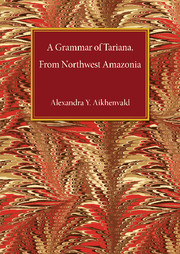Book contents
- Frontmatter
- Dedication
- Contents
- List of tables, schemes and diagrams
- Preface
- Acknowledgements
- Organisation and cross-referencing
- List of abbreviations
- Map
- 1 The language and its speakers
- 2 Phonology
- 3 Word classes
- 4 Nominal morphology and noun structure
- 5 Noun classes and classifiers
- 6 Possession
- 7 Case marking and grammatical relations
- 8 Number
- 9 Further nominal categories
- 10 Derivation and compounding
- 11 Closed word classes
- 12 Verb classes and predicate structure
- 13 Valency changing and argument rearranging mechanisms
- 14 Tense and evidentiality
- 15 Aspect, Aktionsart and degree
- 16 Mood and modality
- 17 Negation
- 18 Serial verb constructions and verb compounding
- 19 Complex predicates
- 20 Participles and nominalisations
- 21 Clause types and other syntactic issues
- 22 Subordinate clauses and clause linking
- 23 Relative clauses
- 24 Complement clauses
- 25 Discourse organisation
- 26 Issues in etymology and semantics
- Appendix. The main features of the Tariana dialects
- Texts
- Vocabulary
- References
- Index of authors, languages and subjects
15 - Aspect, Aktionsart and degree
Published online by Cambridge University Press: 05 August 2013
- Frontmatter
- Dedication
- Contents
- List of tables, schemes and diagrams
- Preface
- Acknowledgements
- Organisation and cross-referencing
- List of abbreviations
- Map
- 1 The language and its speakers
- 2 Phonology
- 3 Word classes
- 4 Nominal morphology and noun structure
- 5 Noun classes and classifiers
- 6 Possession
- 7 Case marking and grammatical relations
- 8 Number
- 9 Further nominal categories
- 10 Derivation and compounding
- 11 Closed word classes
- 12 Verb classes and predicate structure
- 13 Valency changing and argument rearranging mechanisms
- 14 Tense and evidentiality
- 15 Aspect, Aktionsart and degree
- 16 Mood and modality
- 17 Negation
- 18 Serial verb constructions and verb compounding
- 19 Complex predicates
- 20 Participles and nominalisations
- 21 Clause types and other syntactic issues
- 22 Subordinate clauses and clause linking
- 23 Relative clauses
- 24 Complement clauses
- 25 Discourse organisation
- 26 Issues in etymology and semantics
- Appendix. The main features of the Tariana dialects
- Texts
- Vocabulary
- References
- Index of authors, languages and subjects
Summary
Tariana has a number of non-spatial categories which are realised independently of tense-evidentiality marking. We showed in Chapter 12 that the non-spatial setting markers can occur in several different positions within the verb structure. They also display a range of restrictions in their ability to occur with other categories, and with each other.
In §15.1 we consider all the non-spatial setting markers. The Aktionsart enclitics discussed in §15.2 form a coherent class from the point of view of their occurrence, semantics, origins and a few other properties; they occupy one slot in verbal structure (slot 17 in Scheme 12.2). Degree markers are analysed in §15.3, and emphatic markers in §15.4.
Aspect markers
Aspect markers fall within the broad semantic field of ‘completion’ and ‘duration’. They are heterogenous as to their distribution, morphological status and origins. We call them ‘aspectual’ for short.
A complete list of aspectual markers is given in Table 15.1, with an indication of the slot they go into within the verbal structure in Schemes 12.1-2. Most of these are enclitics, and just a few are not. We discuss them one by one, starting from the slots which are closest to the verbal root.
‘Short duration, little by little’ -ina
The marker -ina indicates the short duration of an action or process, as in pi-whawheta-ina (2sg-rest-LITTLE.BY.LITTLE) ‘have a little rest’, see also 15.1; the incipient character of an action or process, as in 15.2; or the short extent of an action (‘come close to’), as in 15.3.
- Type
- Chapter
- Information
- A Grammar of Tariana, from Northwest Amazonia , pp. 324 - 370Publisher: Cambridge University PressPrint publication year: 2003



